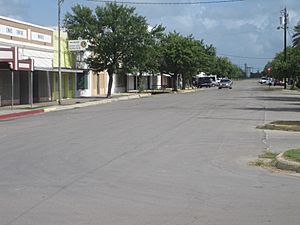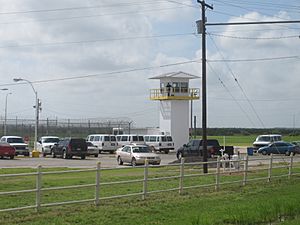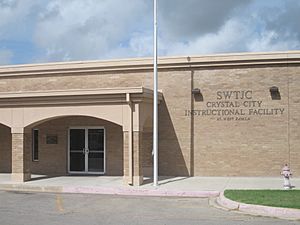Crystal City, Texas facts for kids
Quick facts for kids
Crystal City, Texas
|
|
|---|---|
|
City and county seat
|
|
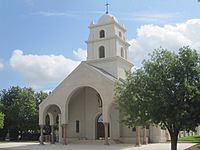
Sacred Heart Catholic Church in Crystal City
|
|
| Nickname(s):
Spinach Capital of the World
|
|
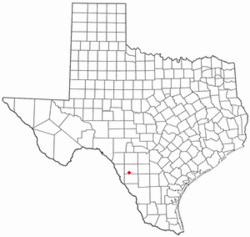
Location of Crystal City, Texas
|
|
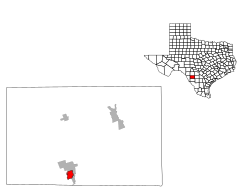 |
|
| Country | United States |
| State | Texas |
| County | Zavala |
| Area | |
| • Total | 3.65 sq mi (9.46 km2) |
| • Land | 3.64 sq mi (9.44 km2) |
| • Water | 0.01 sq mi (0.02 km2) |
| Elevation | 558 ft (170 m) |
| Population
(2020)
|
|
| • Total | 6,354 |
| • Density | 1,740/sq mi (673/km2) |
| Time zone | UTC-6 (Central (CST)) |
| • Summer (DST) | UTC-5 (CDT) |
| ZIP code |
78839
|
| Area code(s) | 830 |
| FIPS code | 48-18020 |
| GNIS feature ID | 1355449 |
Crystal City is a town in Texas, United States. It is the main city of Zavala County. In 2020, about 6,354 people lived there.
The town started as a place for farming and ranching. It was also an important stop for trains. Crystal City is famous for growing a lot of spinach. Because of this, it is known as the "Spinach Capital of the World."
During World War II, a special camp was built here. It housed American civilians whose families were from Germany, Japan, or Italy. Crystal City is also important in the history of Mexican American people. It is where the La Raza Unida Party was started. This party helped Mexican Americans gain more control over their local government.
Contents
History
Farming and Ranching
Crystal City was first settled by American farmers and ranchers. They raised cattle and grew different crops.
Spinach became a very important crop for the town. On March 26, 1937, spinach growers put up a statue of the cartoon character Popeye. They did this because Popeye's love for spinach made the vegetable more popular. Spinach then became a main crop for the local economy.
The area was called the "Spinach Capital of the World." The first Spinach Festival was held in 1936. It stopped during World War II but started again in 1982. The festival happens every November. Many former residents, including those who used to be migrant farm workers, come back for it.
World War II Internment Camp
During World War II, Crystal City had an internment camp. This camp held American civilians. Their families had come from Germany, Japan, and Italy.
Chicano School Walkouts
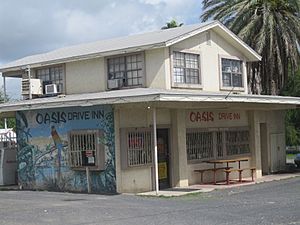
Most people in Crystal City were, and still are, Mexican American. In the late 1960s, many were migrant farmers. They would take their children out of school in the spring. Sometimes they would not return until the fall semester had already started.
During the summer, school leaders made rules. These rules often did not consider the needs of Mexican American students. For example, a school committee decided that only one Mexican American cheerleader was allowed. The rest had to be Anglo (white).
In 1969, two cheerleader spots opened. But Mexican American students were not allowed to try out. This was because one Mexican American cheerleader was already on the team. Students were very upset.
The school board also said that cheerleading candidates needed a parent who graduated from the high school. When students complained, the superintendent tried to fix it. He said there should be three Mexican American and three Anglo cheerleaders.
But Anglo parents complained. The school board then canceled the superintendent's idea. They made a new rule: any student protests would lead to expulsion.
Student leaders took their concerns to the school board. They asked for more Hispanic teachers and counselors. They also wanted more challenging classes. They asked for bilingual education and Mexican American studies. And they wanted a student on the school board.
The school board refused to listen. So, on December 9, 1969, students walked out of school. More than 2,000 students joined the protest. Even elementary and junior high students joined in.
The Texas Education Agency (TEA) sent people to help. They tried to get the students back to school. The TEA suggested closing schools early for Christmas. But the school board said no.
Texas Senator Ralph Yarborough invited three student leaders to Washington, D.C. They talked about unfair treatment in their schools. They also met with Senators Edward Kennedy and George McGovern. These senators told the Department of Justice about the situation.
During the Christmas break, a group called Texans for the Educational Advancement of Mexican Americans (TEAMA) taught the students.
Finally, the school board agreed to a meeting. On January 9, 1970, the students' demands were approved. This victory made the community stronger. That spring, Mexican American candidates won most school board and city council elections.
Within two years, most teachers, administrators, and the superintendent were Mexican American. More students graduated from high school. Many went on to college. Some of the student leaders from the walkout later held important jobs in the school and local government.
La Raza Unida Party
By the late 1960s, Crystal City became a center for the civil rights movement. This was for its Mexican American majority population. It was also the birthplace of a political party called La Raza Unida Party.
Three Chicano leaders, including José Ángel Gutiérrez, started the party. This happened after a disagreement about cheerleaders at Crystal City High School. La Raza Unida and related groups won many elections in Crystal City and Zavala County. This happened between 1969 and 1980.
In the 1970s, Crystal City's natural gas supply was cut off. This happened after protests by La Raza Unida about service charges. People in Crystal City then used wood-burning stoves and propane tanks for cooking.
Geography
Crystal City covers about 3.6 square miles (9.4 square kilometers) of land. There are no large bodies of water within the city limits.
Important rivers and lakes near Crystal City include the Nueces River and Averhoff Reservoir. The soil in the area is usually reddish-brown or grayish-brown. It is often sandy or clay-like.
Demographics
| Historical population | |||
|---|---|---|---|
| Census | Pop. | %± | |
| 1930 | 6,609 | — | |
| 1940 | 6,529 | −1.2% | |
| 1950 | 7,198 | 10.2% | |
| 1960 | 9,101 | 26.4% | |
| 1970 | 8,104 | −11.0% | |
| 1980 | 8,334 | 2.8% | |
| 1990 | 8,263 | −0.9% | |
| 2000 | 7,190 | −13.0% | |
| 2010 | 7,138 | −0.7% | |
| 2020 | 6,354 | −11.0% | |
| U.S. Decennial Census | |||
2020 Census
| Race | Number | Percentage |
|---|---|---|
| White (NH) | 187 | 2.94% |
| Black or African American (NH) | 51 | 0.8% |
| Native American or Alaska Native (NH) | 16 | 0.25% |
| Asian (NH) | 10 | 0.16% |
| Some Other Race (NH) | 3 | 0.05% |
| Mixed/Multi-Racial (NH) | 26 | 0.41% |
| Hispanic or Latino | 6,061 | 95.39% |
| Total | 6,354 |
As of the 2020 United States census, there were 6,354 people living in Crystal City. There were 2,458 households and 2,050 families.
Economy
The Crystal City Correctional Center was once a major employer in the area. It was a private facility that housed prisoners.
Transportation
Crystal City is served by several roads. These include U.S. Route 83 and Farm to Market Roads 65, 582, and 1433.
Education
The Crystal City Independent School District serves the town. The high school sports teams are called the Javelinas.
Crystal City also has a branch of Southwest Texas Junior College. Its main campus is in Uvalde, to the north.
Images for kids
See also
 In Spanish: Crystal City (Texas) para niños
In Spanish: Crystal City (Texas) para niños


